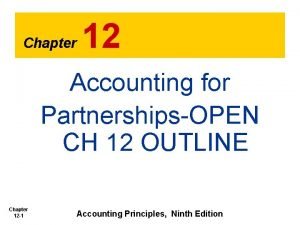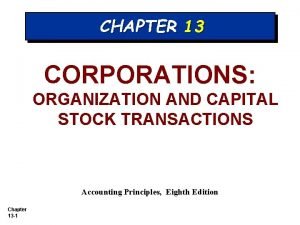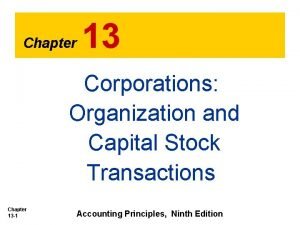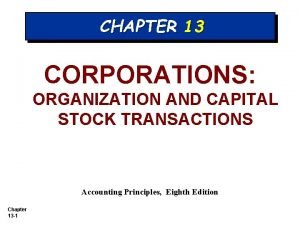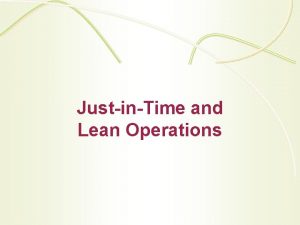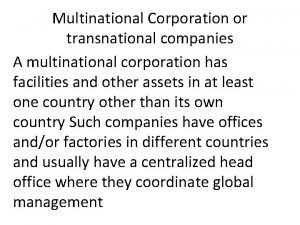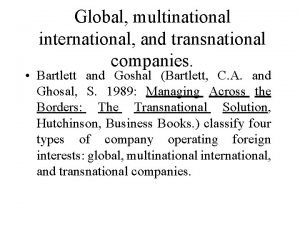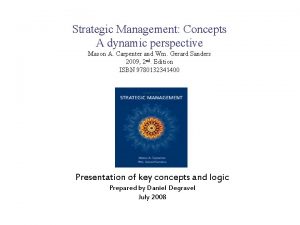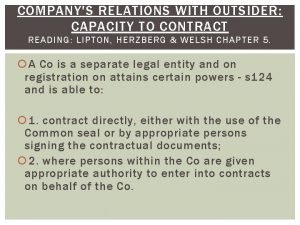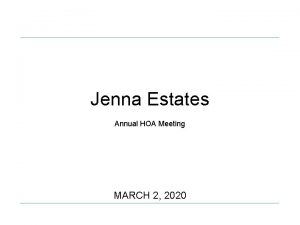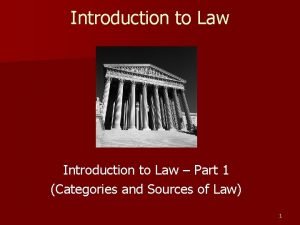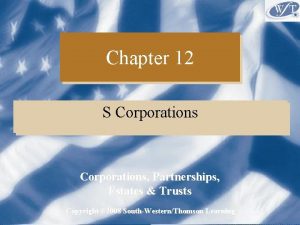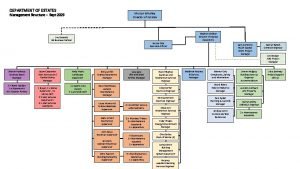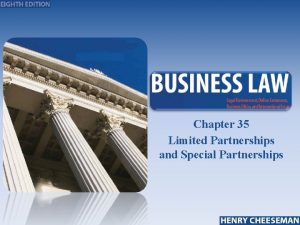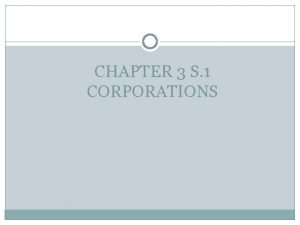Chapter 3 Corporations Special Situations Corporations Partnerships Estates




































- Slides: 36

Chapter 3 Corporations: Special Situations Corporations, Partnerships, Estates & Trusts Copyright © 2010 Cengage Learning Corporations, Partnerships, Estates & Trusts C 3 - 1

Domestic Production Activities Deduction (slide 1 of 5) • The American Jobs Creation Act of 2004 created a new deduction based on the income from manufacturing activities – The domestic production activities deduction (DPAD) is based on the following formula: • 6% × Lesser of – Qualified production activities income – Taxable income (or modified AGI) or AMTI – The deduction cannot exceed 50% of an employer’s W – 2 wages properly allocable to domestic production gross receipts Corporations, Partnerships, Estates & Trusts C 3 - 2

Domestic Production Activities Deduction (slide 2 of 5) • A phase-in provision increases the applicable rate for the production activities deduction as follows: Rate Years 3% 2005 -2006 6% 2007 -2009 9% 2010 and thereafter Corporations, Partnerships, Estates & Trusts C 3 - 3

Domestic Production Activities Deduction (slide 3 of 5) • Eligible taxpayers include: – Individuals, partnerships, S corporations, C corporations, cooperatives, estates, and trusts • For a pass-through entity (e. g. , partnerships, S corporations), the deduction flows through to the individual owners • For sole proprietors, a deduction for AGI results • For C corporations, the deduction is included with other expenses in computing corporate taxable income Corporations, Partnerships, Estates & Trusts C 3 - 4

Domestic Production Activities Deduction (slide 4 of 5) • Qualified production activities income is the excess of domestic production gross receipts over: – Cost of goods sold (CGS) – Direct costs – Allocable indirect costs Corporations, Partnerships, Estates & Trusts C 3 - 5

Domestic Production Activities Deduction (slide 5 of 5) • Domestic production gross receipts (DPGR) include receipts from: – Lease, rental, license, sale, exchange, or other disposition of qualified production property (QPP) that was manufactured, produced, grown, or extracted in the U. S. – Qualified films largely created in the U. S. – Production of electricity, natural gas, or potable water – Construction performed in the U. S. – Engineering and architectural services for domestic construction Corporations, Partnerships, Estates & Trusts C 3 - 6

Alternative Minimum Tax (slide 1 of 3) • Designed to ensure that corporations with substantial economic income pay at least a minimum amount of federal taxes • Essentially, a separate tax system with a quasi-flat tax rate applied to a corporation’s economic income Corporations, Partnerships, Estates & Trusts C 3 - 7

Alternative Minimum Tax (slide 2 of 3) • If tentative alternative minimum tax > regular corporate income tax, corporation must pay regular tax plus the excess, the alternative minimum tax (AMT) Corporations, Partnerships, Estates & Trusts C 3 - 8

Alternative Minimum Tax (slide 3 of 3) • For tax years beginning after 1997, many small corporations are not subject to AMT – A small corporation has average annual gross receipts of $5 million or less for the preceding three-year period – Small corporation continues to qualify as long as average gross receipts for the preceding three-year period do not exceed $7. 5 million Corporations, Partnerships, Estates & Trusts C 3 - 9

AMT Formula for Corporations (slide 1 of 2) Regular Taxable Income Before NOL Deduction ± AMT Adjustments (except ACE adjustment) + Tax preferences = AMTI before AMT NOL deduction and ACE adjust. ± ACE adjustment = AMTI before AMT NOL – AMT NOL (limited to 90% of above amount) = Alternative minimum taxable income (AMTI) Corporations, Partnerships, Estates & Trusts C 3 - 10

AMT Formula for Corporations (slide 2 of 2) Alternative minimum taxable income (AMTI) – Exemption = Tentative minimum tax base × 20% rate = Tentative minimum tax before AMT foreign tax credit – AMT foreign tax credit = Tentative minimum tax – Regular tax liability before credits minus reg FTC = Alternative minimum tax (AMT) if positive Corporations, Partnerships, Estates & Trusts C 3 - 11

Adjustments for AMT (slide 1 of 2) Adjustments for AMT: • A portion of depreciation on property placed in service after 1986 • Difference between gain(loss) on sale of property for regular tax and AMT purposes • Passive activity losses of certain closely held corporations and personal service corporations • Mining exploration and development costs in excess of allowed AMT 10 year amortization Corporations, Partnerships, Estates & Trusts C 3 - 12

Adjustments for AMT (slide 2 of 2) Adjustments for AMT (cont’d): • Difference between percentage of completion and completed contract income • Amortization claimed on certified pollution control facilities • Difference between installment gain and total gain on certain dealer sales • A portion of the difference between “ACE” and unadjusted AMTI Corporations, Partnerships, Estates & Trusts C 3 - 13

Tax Preference Items • Accelerated depreciation on real property in excess of straight-line for property placed in service before 1987 • Tax-exempt interest on “private activity bonds” • Percentage depletion in excess of the adjusted basis of property • Certain intangible drilling costs for “integrated oil companies” Corporations, Partnerships, Estates & Trusts C 3 - 14

ACE Adjustment (slide 1 of 3) • Ace adjustment = 75% of difference between unadjusted AMTI and ACE – Can be positive or negative – Negative adjustment is limited to aggregate positive adjustments less previous negative adjustments Corporations, Partnerships, Estates & Trusts C 3 - 15

ACE Adjustment (slide 2 of 3) • Starting point for determining ACE is AMTI – AMTI is defined as regular taxable income after AMT adjustments and tax preferences (other than the NOL and ACE adjustments) Corporations, Partnerships, Estates & Trusts C 3 - 16

ACE Adjustment (slide 3 of 3) • AMTI is adjusted to arrive at ACE – These adjustments include: • Exclusion items—Income items that will never be included in regular taxable income or AMTI • Disallowed items – e. g. , dividends received deduction of 70% (less than 20% ownership) • Other adjustments items including, for example, intangible drilling costs, circulation expenditures, organization expense amortization, LIFO inventory adjustments, installment sales, other items Corporations, Partnerships, Estates & Trusts C 3 - 17

Impact of Certain Transactions on ACE (slide 1 of 2) Corporations, Partnerships, Estates & Trusts C 3 - 18

Impact of Certain Transactions on ACE (slide 2 of 2) Corporations, Partnerships, Estates & Trusts C 3 - 19

Exemption • Exemption amount for a corp = $40, 000 – Reduced by 25% of excess of AMTI over $150, 000 – Exemption is totally phased-out when AMTI reaches $310, 000 Corporations, Partnerships, Estates & Trusts C 3 - 20

Minimum Tax Credit (slide 1 of 2) • AMT paid in one year can be used as a credit against future regular tax liability that exceeds its tentative minimum tax – Indefinite carryforward – Cannot be carried back – Cannot offset any future minimum tax liability Corporations, Partnerships, Estates & Trusts C 3 - 21

Minimum Tax Credit (slide 2 of 2) • Small corporations (no longer subject to AMT) with unused minimum tax credits after 1997 may use them against regular tax liability • Limit = regular tax – [25% × (regular tax – $25, 000)] Corporations, Partnerships, Estates & Trusts C 3 - 22

AMT Example (slide 1 of 4) Moreland Co. has the following income, etc. in 2009: Taxable income $100, 000 Depreciation adjustment 18, 000 Installment gain (not on inventory sale) Federal income tax provision on financial stmts. 75, 000 Penalties and fines 2, 000 Private activity bond interest income Other tax-exempt interest 20, 000 80, 000 25, 000 – The depreciation adjustment is an AMT adjustment and the private activity bond interest is a tax preference for AMTI. Corporations, Partnerships, Estates & Trusts C 3 - 23

AMT Example (slide 2 of 4) Calculation of AMTI before ACE: Taxable income Plus: private activity bond income Plus: depreciation adjustment AMTI Corporations, Partnerships, Estates & Trusts $100, 000 25, 000 18, 000 $143, 000 C 3 - 24

AMT Example (slide 3 of 4) Calculation of ACE Adjustment: AMTI before ACE Plus: deferred installment gain Plus: other tax-exempt income Adjusted current earnings Less: AMTI Base amount for Ace Adjustment Times rate: ACE Adjustment (positive) Corporations, Partnerships, Estates & Trusts $143, 000 80, 000 20, 000 $243, 000 143, 000 $100, 000 75% $75, 000 C 3 - 25

AMT Example (slide 4 of 4) Calculation of AMT: AMTI before ACE $143, 000 Plus: ACE Adjustment 75, 000 AMTI $218, 000 Less: Exemption 23, 000 Tentative minimum tax base $195, 000 20% rate × 20% Tentative minimum tax $ 39, 000 Less: regular tax (22, 250) AMT(TMT-Regular tax) $ 16, 750 Total cash paid = Regular tax + AMT = $ 39, 000 Corporations, Partnerships, Estates & Trusts C 3 - 26

Accumulated Earnings Tax (slide 1 of 5) • Penalty tax designed to discourage the retention of corporate earnings unrelated to the business needs of the company Corporations, Partnerships, Estates & Trusts C 3 - 27

Accumulated Earnings Tax (slide 2 of 5) • Tax of 15% is imposed on accumulated taxable income (ATI), determined as follows: ATI = Taxable income ± Adjustments - Dividends paid - Accumulated earnings credit • Adjustments to taxable income generally pertain to a corporation’s ability to pay a dividend – Thus, deductions include the corporate income tax and excess charitable contributions, while additions include the NOL and dividends received deductions Corporations, Partnerships, Estates & Trusts C 3 - 28

Accumulated Earnings Tax (slide 3 of 5) • An accumulated earnings credit is allowed even when accumulations are beyond reasonable business needs Corporations, Partnerships, Estates & Trusts C 3 - 29

Accumulated Earnings Tax (slide 4 of 5) • The accumulated earnings credit is the greater of: – Current E&P needed to meet “reasonable needs” of the business, or – Amount by which $250, 000 ($150, 000 for service companies) exceeds Accumulated E&P as of close of preceding tax year (the minimum credit) Corporations, Partnerships, Estates & Trusts C 3 - 30

Accumulated Earnings Tax - Reasonable Needs Of The Business (slide 5 of 5) • Legitimate reasons • Invalid Reasons – Business expansion – Capital asset replacement – Working capital needs – Product liability loss – Loans to suppliers or customers Corporations, Partnerships, Estates & Trusts – Loans to shareholders – Unrealistic contingencies – Investment in unrelated business assets C 3 - 31

Personal Holding Company Tax • Personal Holding Company (PHC) tax is designed to discourage sheltering of certain types of passive income in corporations – Like the accumulated earnings tax, the purpose is to force the distribution of corporate earnings to shareholders Corporations, Partnerships, Estates & Trusts C 3 - 32

Definition of PHC • A company is a PHC if: – More than 50% of the value of stock is owned by 5 or fewer individuals during the last half of the year • Broad constructive ownership rules apply in determining stock ownership – 60% or more of gross income (as adjusted) must consist of personal holding company income (PHCI) • Examples are dividends, interest, rents, royalties, or certain personal service income • Rents or royalties may be excluded if they are significant in amount (i. e. , comprise more than 50% of the adjusted gross income) Corporations, Partnerships, Estates & Trusts C 3 - 33

Calculation of PHC Tax • Once classified as a PHC, the tax base must be calculated – Penalty tax rate = 15% – Tax base is undistributed Personal Holding Company income (UPHC income) • Amount is taxable income plus or minus certain adjustments, minus the dividends paid deduction Corporations, Partnerships, Estates & Trusts C 3 - 34

Dividends Paid • Dividend payments reduce both ATI and undistributed PHCI – As these are the bases on which the § 531 tax or the § 541 tax is imposed, either tax can be completely avoided by paying sufficient dividends Corporations, Partnerships, Estates & Trusts C 3 - 35

If you have any comments or suggestions concerning this Power. Point Presentation for South-Western Federal Taxation, please contact: Dr. Donald R. Trippeer, CPA trippedr @oneonta. edu SUNY Oneonta Corporations, Partnerships, Estates & Trusts C 3 - 36
 Accounting for partnerships chapter 12 solutions
Accounting for partnerships chapter 12 solutions Chapter 12 accounting for partnerships answers
Chapter 12 accounting for partnerships answers Chapter 7 corporations act
Chapter 7 corporations act Characteristics of corporation
Characteristics of corporation Characteristics of corporation
Characteristics of corporation Learnnowbiz
Learnnowbiz Accounting for corporations chapter 13
Accounting for corporations chapter 13 Adp accenture
Adp accenture Word partnership examples
Word partnership examples Product development partnerships
Product development partnerships Jit scheduling tactics
Jit scheduling tactics Maintaining effective partnerships
Maintaining effective partnerships Public partnerships my account registration
Public partnerships my account registration Epsrc prosperity partnerships
Epsrc prosperity partnerships Disadvantages of multinational corporation
Disadvantages of multinational corporation Difference between global company and multinational company
Difference between global company and multinational company Disadvantages of corporations
Disadvantages of corporations Corporations mergers and multinationals
Corporations mergers and multinationals Multinational definition business
Multinational definition business Fighting means corporations
Fighting means corporations Types of corporations
Types of corporations Equiticorp finance v bnz
Equiticorp finance v bnz How to control multinational corporations
How to control multinational corporations Domestic structures
Domestic structures Objectives of mnc
Objectives of mnc Corporations developed rapidly in the 1830s
Corporations developed rapidly in the 1830s Characteristics of corporation
Characteristics of corporation 3 estates cartoon
3 estates cartoon Great estates club
Great estates club Cause of the french revolution
Cause of the french revolution What's an industrial estate
What's an industrial estate Jenna estates hoa
Jenna estates hoa Common law
Common law Define “industrial estates”.
Define “industrial estates”. Mussett v bingle 1876
Mussett v bingle 1876 Trellis ridge estates
Trellis ridge estates French revolution cartoon
French revolution cartoon

